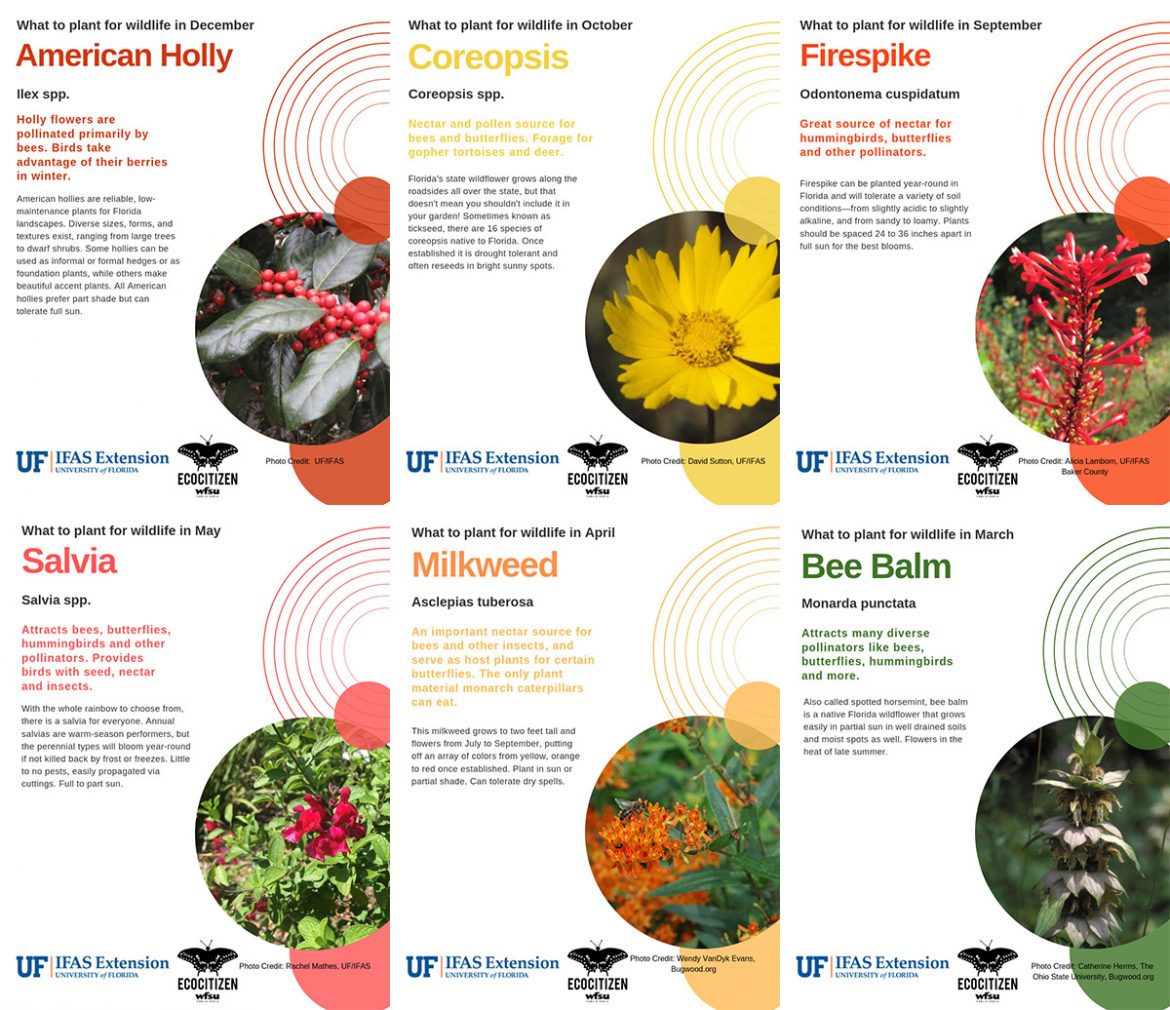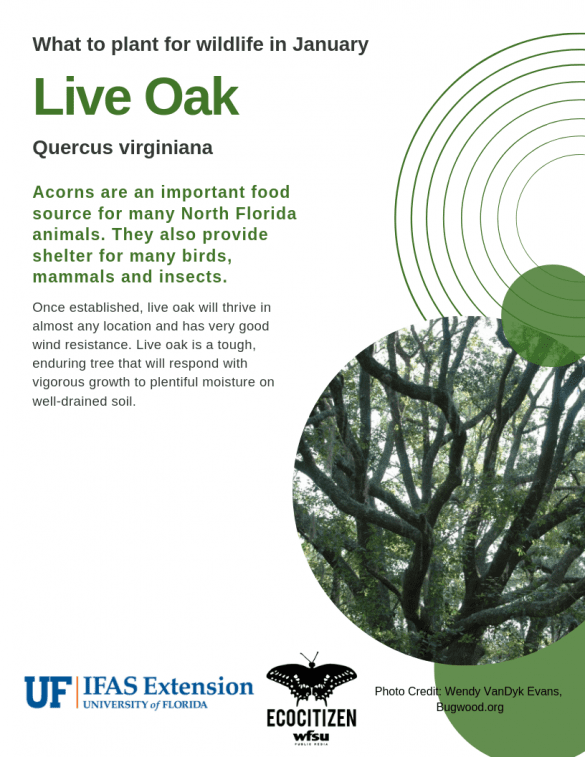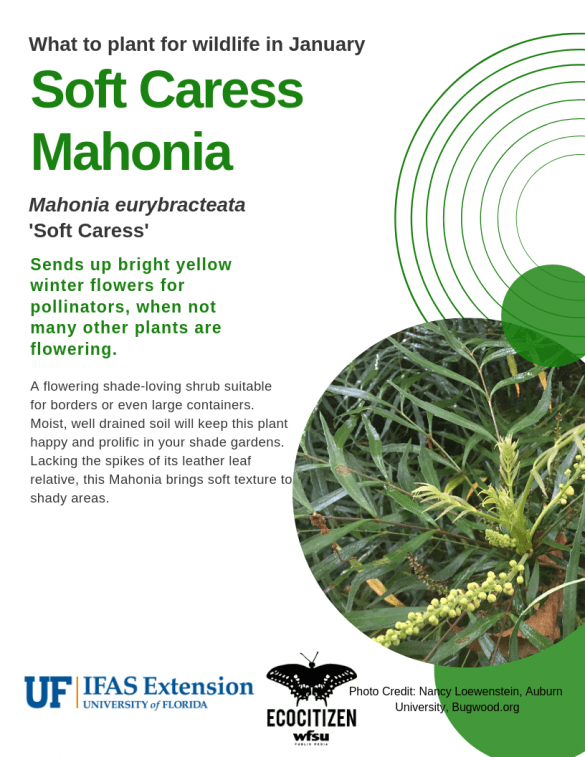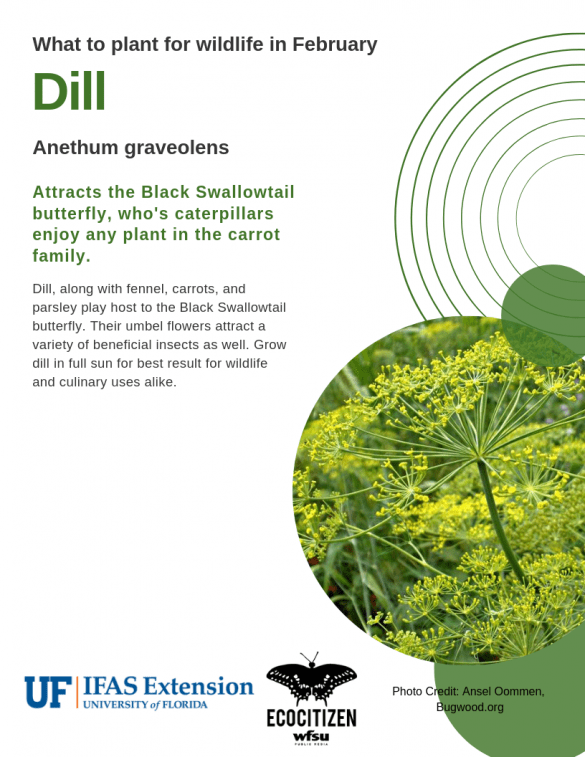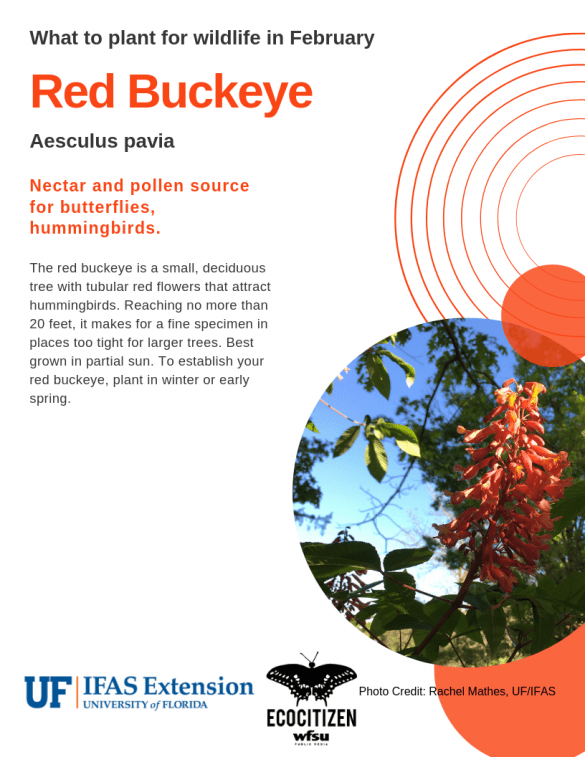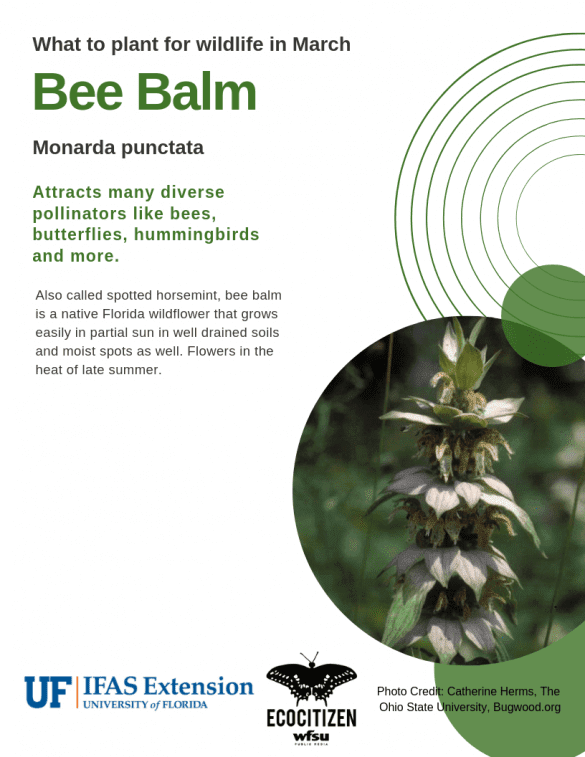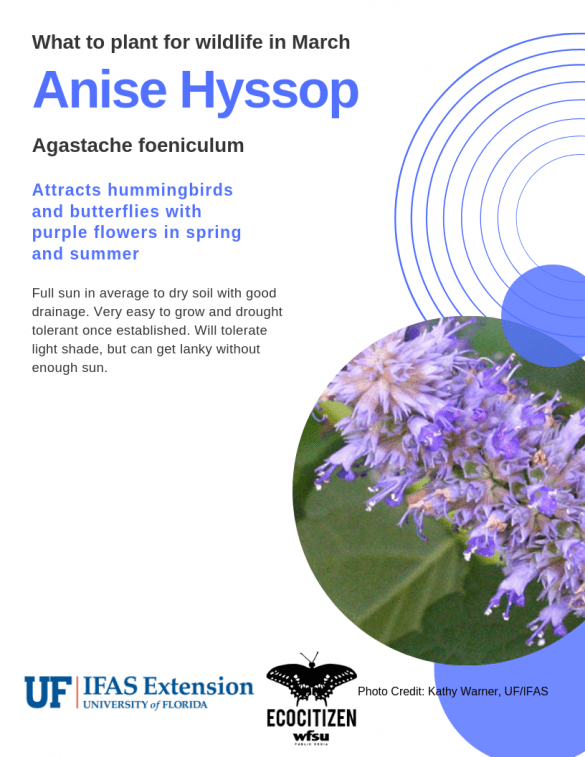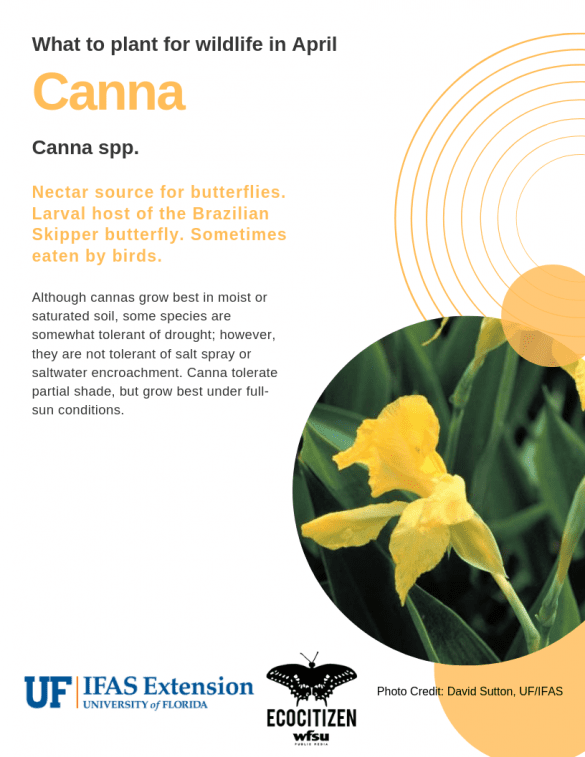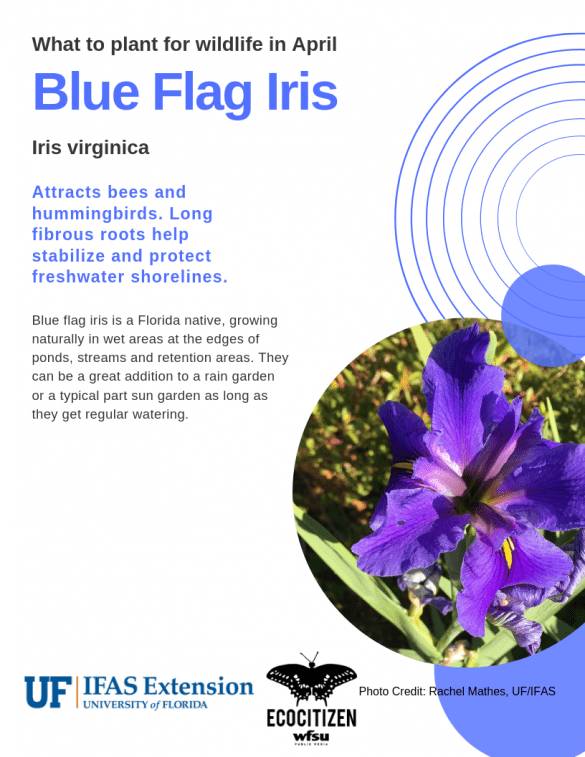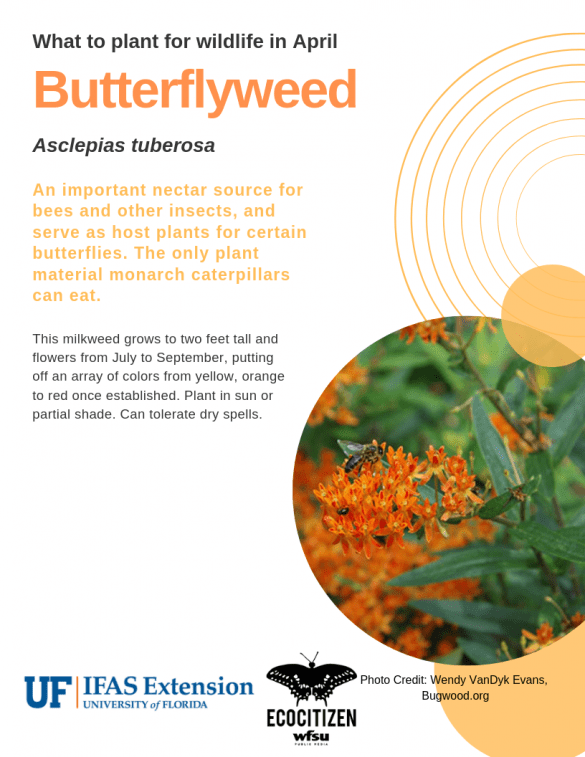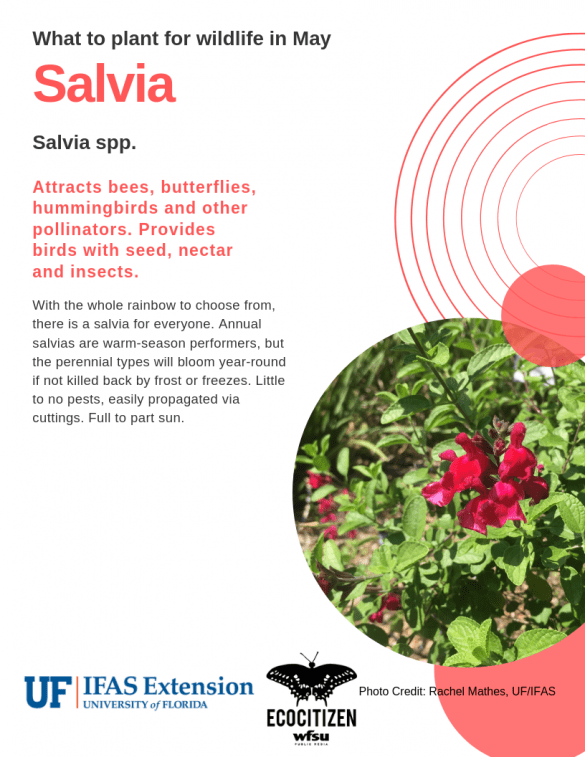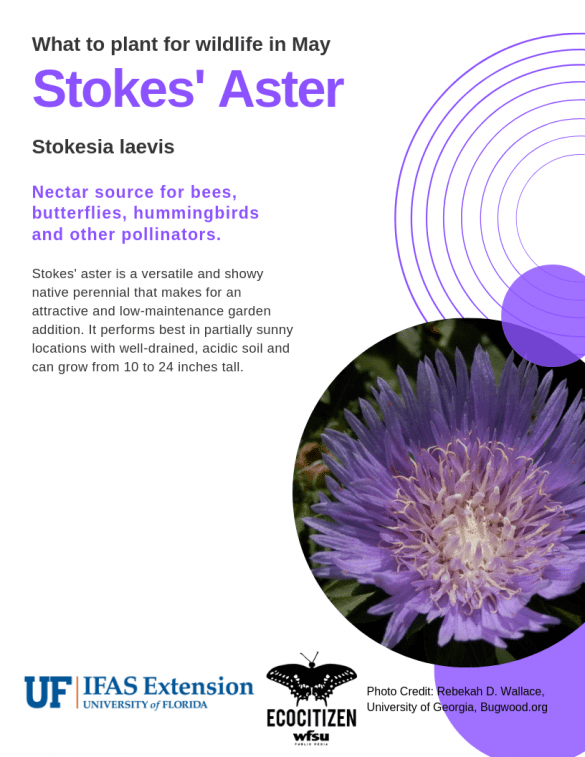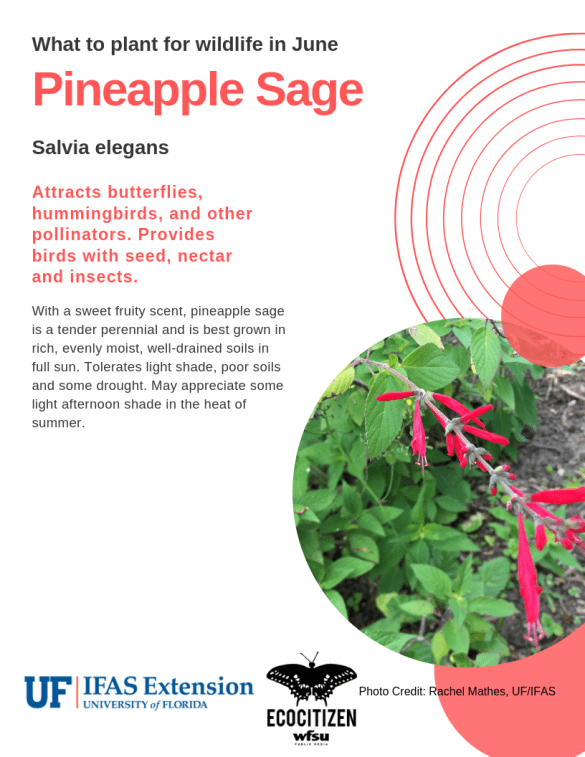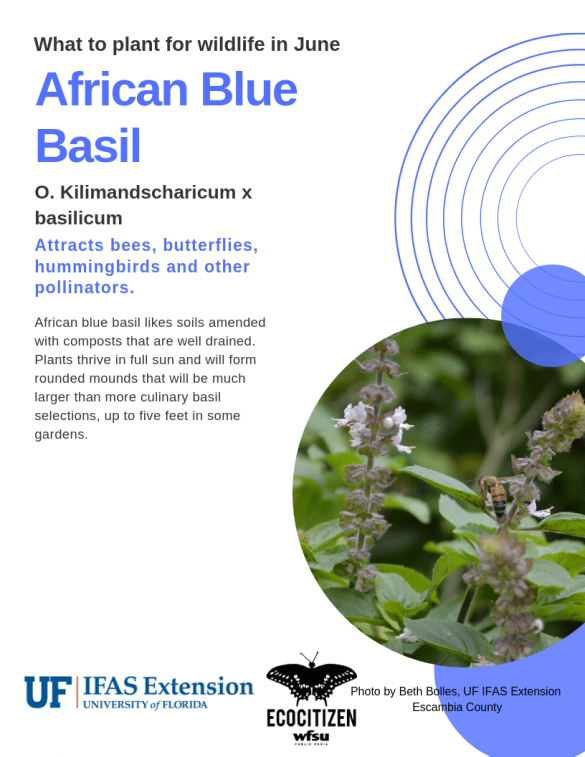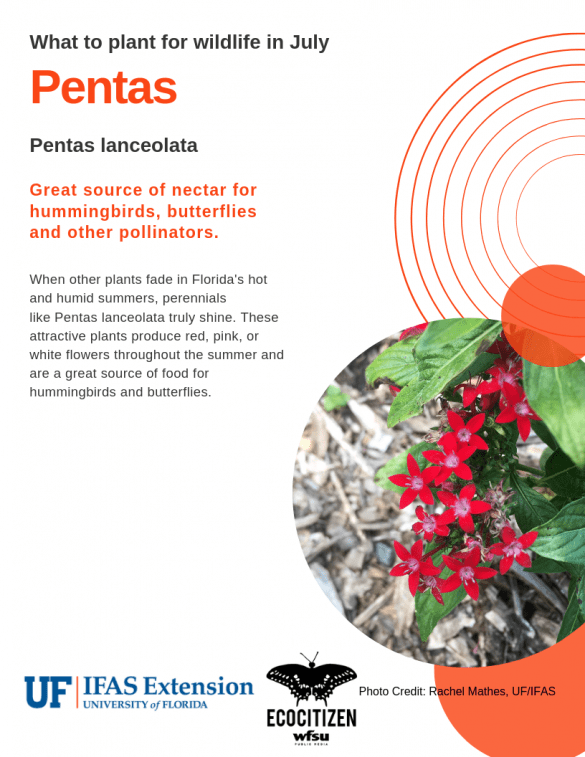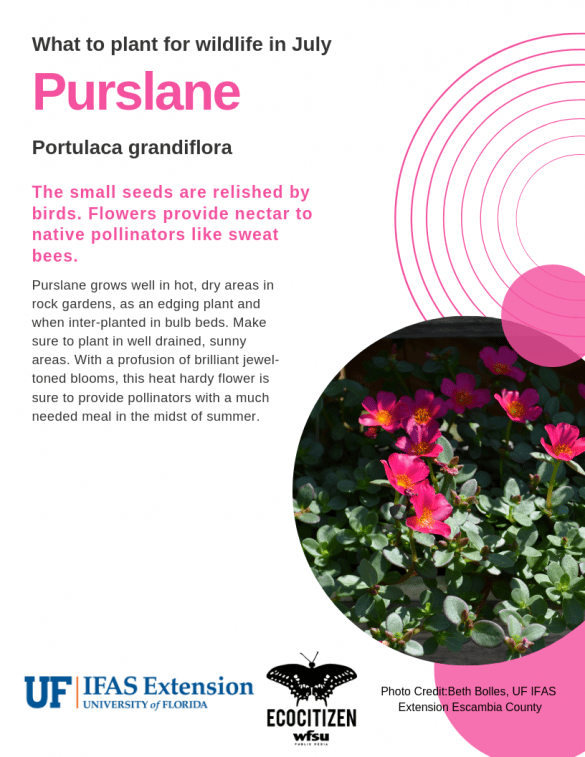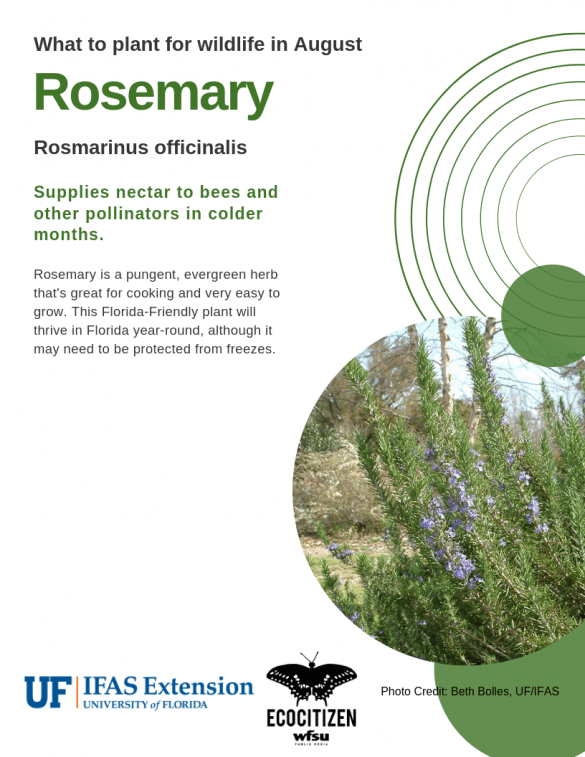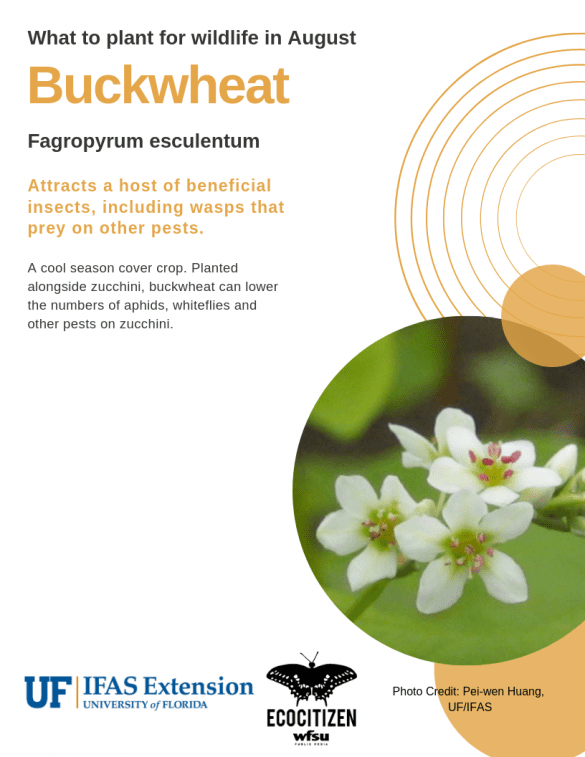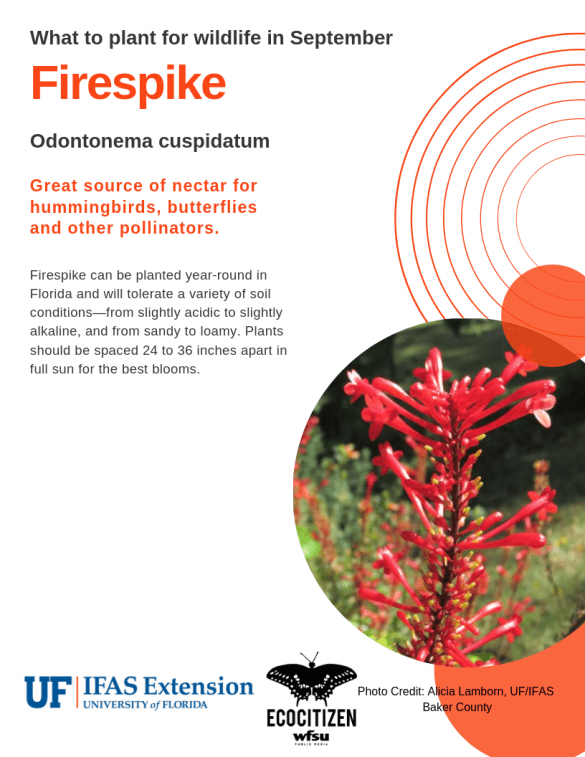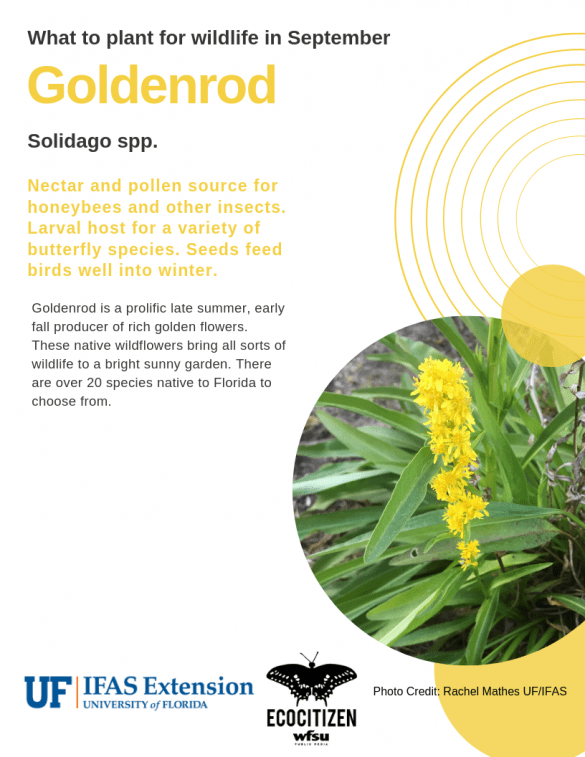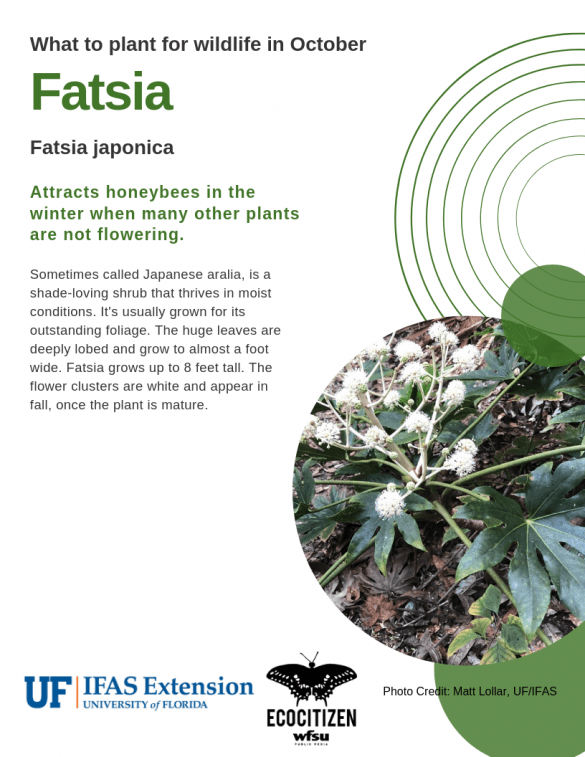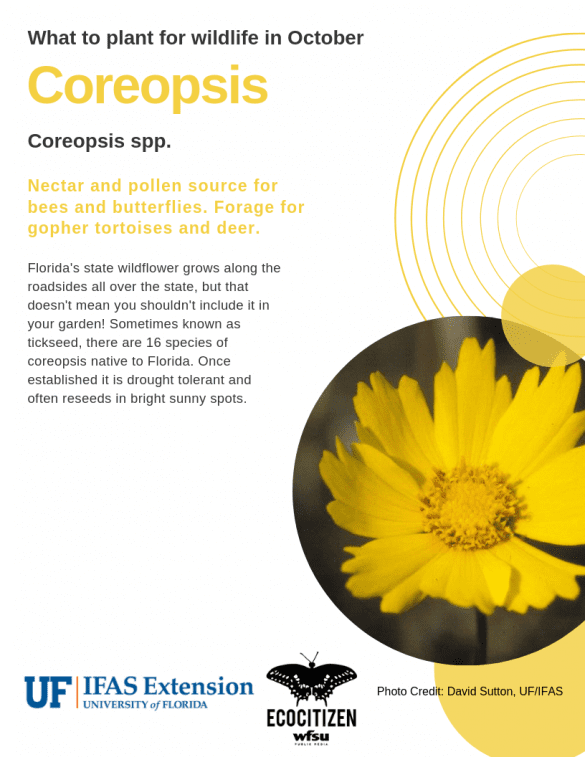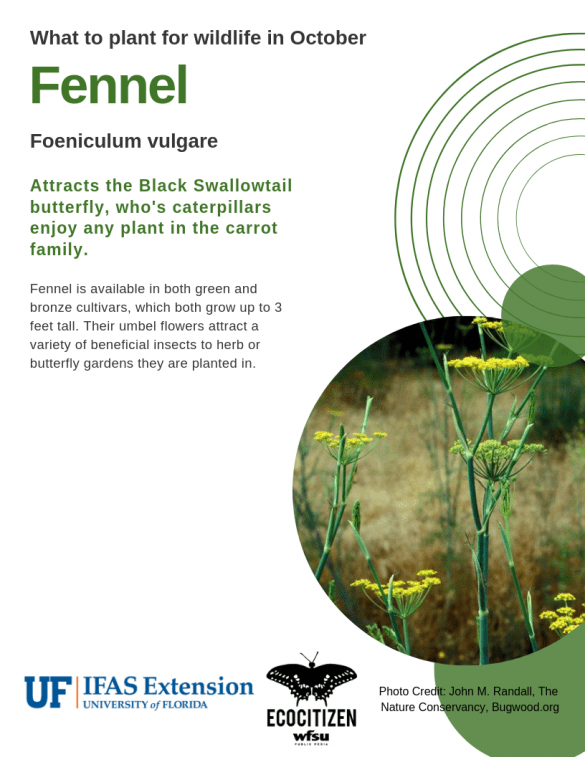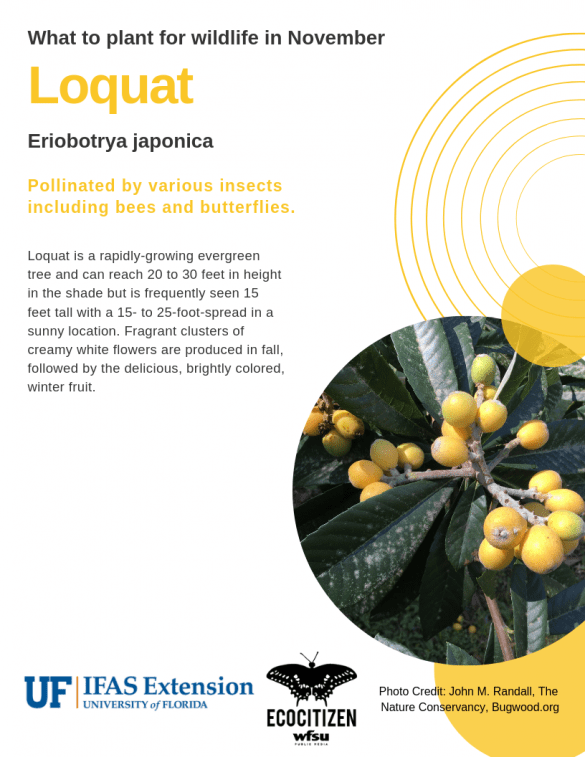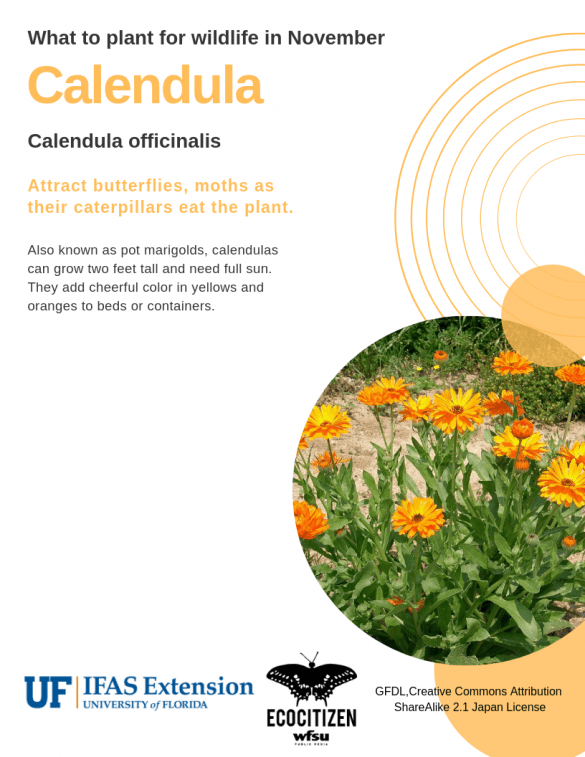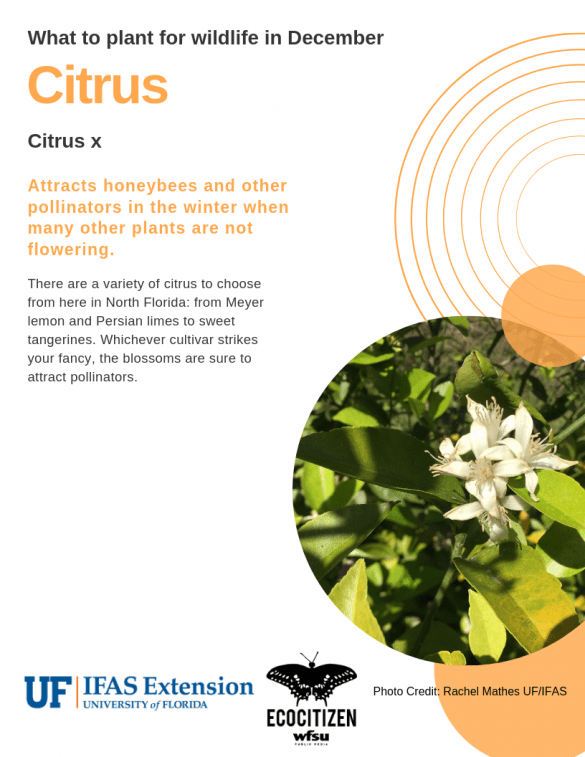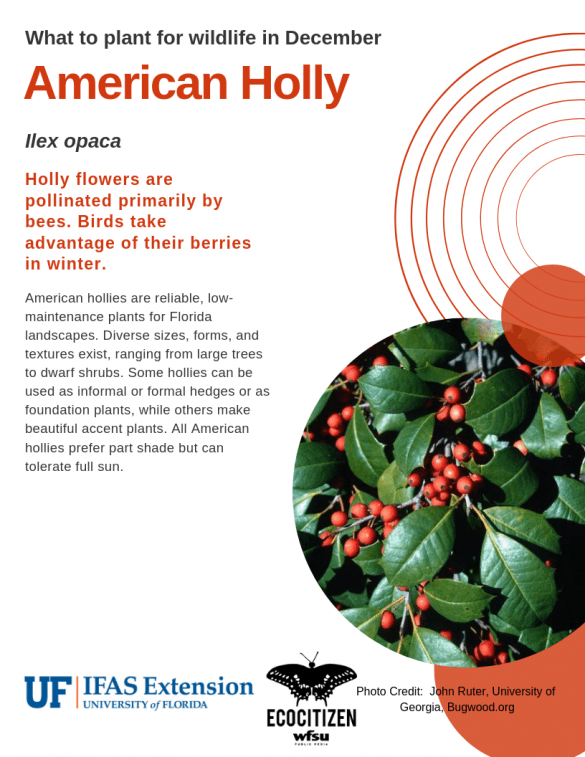One of the pillars of our EcoCitizen Project is creating or enhancing our home habitats. The plants we choose determine the birds and pollinating insects we see in our yards. With that in mind, the Leon County IFAS Extension has created a series of infographics on plants you can plant throughout the year.
The University of Florida Institute of Food and Agricultural Sciences (IFAS) offers a wealth of resources centered on their nine principles for creating a Florida Friendly Yard.
The plants spotlighted below are a combination of Florida natives and non-native plants that benefit native animals. For instance, fennel and dill are not native, but host black swallowtail butterfly caterpillars. Thank you to Rachel Mathes, Horticulture Program Assistant at Leon County IFAS, for creating these attractive, informative graphics.
January
Live Oak (Quercus virginiana)
A classic Floridian icon, live oak does well in well-watered soil and grows to be tough, hardy tree. Insects, birds, and mammals will benefit from its acorns and its sheltering hollows and branches.
Check out our in depth, two part look at live oaks in Tallahassee.
Mahonia (Mahonia bealei)
Mahonia thrives in dry, shady conditions and is an important resource for many animals despite its rugged appearance. In the winter, its flowers provide opportunities for pollinators; in summer, its fruit provides nutrition for birds.
February
Dill (Antheum graveolens)
A sun-loving plant, dill is enjoyed by many animals big and small, from pollinating insects to humans. Black swallowtail caterpillars flourish on dill plants, and it also serves as a complement for culinary herbs and garnish.
Red Buckeye (Aesculus pavia)
Small by tree standards, but the red buckeye is nonetheless an attractive addition to any garden. Its brightly colored flowers also attract hummingbirds. Plant in winter or early spring in partial sun.
March
Bee Balm (Monarda punctata)
Bee balm- aka dotted horsemint- is great for attracting diverse pollinators, such as bees, solitary wasps, and hummingbirds. It enjoys partial sun and moist soil and flowers in the late summer. Check out bee balm in action at the Cherokee Lake Pollinator Garden.
Anise Hyssop (Agastache foeniculum)
With its intricate purple flowers, anise hyssop serves as a great balance between attractiveness and durability. It requires full sun, but it tolerates dry soil and is resistant to drought when established.
April
Canna (Canna spp.)
Canna is a viable source of nectar for butterflies and food for birds. It also hosts the Brazilian skipper butterfly’s larvae. Canna thrives best in moist soil under full sun.
Blue Flag Iris (Iris virginica)
In the wild, blue flag iris grows along the saturated shorelines of ponds and small streams. In your backyard, it thrives best in rain gardens, and partial sun areas as long as they are regularly watered. Great for attracting bees and hummingbirds.
Milkweed/Butterfly weed (Asclepias tuberosa)
Butterfly weed is a hardy plant that can tolerate dry spells and partial shade. Its fiery flowers are magnetic to pollinating insects. Milkweed is also the only plant monarch butterflies will lay their eggs on.
For more information about raising native varieties of milkweed, visit this post from 2019.
May
Salvia (Salvia spp.)
Salvia comes in a vast array of different colors, and some will bloom year-round barring a severe freeze. It serves well in attracting pollinators, and birds will enjoy its seeds and nectar.
Stoke’s Aster (Stokesia laevis)
Despite its striking appearance, Stoke’s aster is low-maintenance and thrives in partial sun. It is also eye-popping to all sorts of pollinators.
June
Pineapple Sage (Salvia elegans)
Pineapple sage serves pollinators and seed-eating birds, and it also has a dazzling look and delectable fruity smell. It does best in light shade and can tolerate substandard soil and drought.
African Blue Basil (O. Kilimandscharicum x basilicum)
It requires full sun and well-drained, amended soil, but African blue basil is a rewarding plant that grows in clusters called “mounds.” Although it is not a culinary basil, bees, butterflies and hummingbirds will find it appealing and beneficial.
July
Pentas (Pentas lanceolata)
Florida’s summers can be brutal for most plants, but pentas are a diverse and hardy addition for your garden. With red, white, and pink varieties, they will also catch the attention of pollinators.
Purslane (Portulaca grandiflora)
Purslane is an attractive addition to rock gardens as well as typical gardens. They thrive in sunny, well-drained soil and can easily tolerate the heat of the summer. They are also a great source of food for birds and native pollinators.
August
Rosemary (Rosemarinus officinalis)
In colder months, rosemary comes through in providing nectar to bees and other pollinators. Easy to grow and hardy, it also adds a savory kick to your culinary endeavors.
Buckwheat (Fagropyrum esculentum)
Buckwheat serves a unique purpose as a guard for vegetables, especially zucchini. It can lower the numbers of aphids and other pest insects, and it also attracts wasps that prey on pests.
September
Firespike (Odontonema cuspidatum)
Firespike provides ample nectar for pollinators, and it it also a hardy and dazzling plant for your garden. It requires full sun, but firespike will also tolerate a wide variety of soils, of all acidities and compositions.
Goldenrod (Solidago spp.)
In the late summer and early fall, goldenrod adds an appealing yellow kick to your garden. Honeybees pollinate it, butterflies lay their eggs on it, and its seeds will feed birds year round.
October
Fatsia (Fatsia japonica)
Fatsia thrives in moist, shady areas, flowers throughout the winter, and can grow to be eight feet tall. Its long-lasting flowers attract honeybees in the winter when most other plants lie dormant.
Coreopsis (Coreopsis spp.)
A common sight around Florida (and its state wildflower), coreopsis serves as an important source of nectar for pollinators and also feeds deer and gopher tortoises. It requires full sun and it is drought tolerant once established.
Fennel (Foeniculum vulgare)
Attractive and prolific, fennel is also beneficial to all sorts of pollinating insects. Black swallowtail butterflies especially enjoy fennel as a host plant to lay their eggs on.
November
Loquat (Eriobotrya japonica)
Loquat is a fast-growing evergreen tree that thrives in both sun and shade. Its fall flowers provide nectar for butterflies and bees, and its winter fruit is delectable on its own or in all sorts of recipes.
Calendula (Calendula officinalis)
The dazzlingly-colored calendula thrives best in full sun and is a great addition to containers and beds. Butterflies and moths of all species will find the calendula a perfect place to lay their eggs.
December
American Holly (Ilex spp.)
American holly is diverse, hardy, and efficient for all sorts of purposes, such as landscaping and ornamentals. It can tolerate both full sun and partial shade. Its signature red berries are an important food source for birds in the winter, in particular, cedar waxwings. Indigenous Floridians used holly berries to make their ceremonial black drink.
Citrus (Citrus x)
Another botanical Florida icon, citrus plants are diverse and beneficial to both pollinators and your palette. Their flowering in the winter means pollinators will rely on them when other plants lie dormant. Citrus plants will also host giant swallowtail caterpillars.
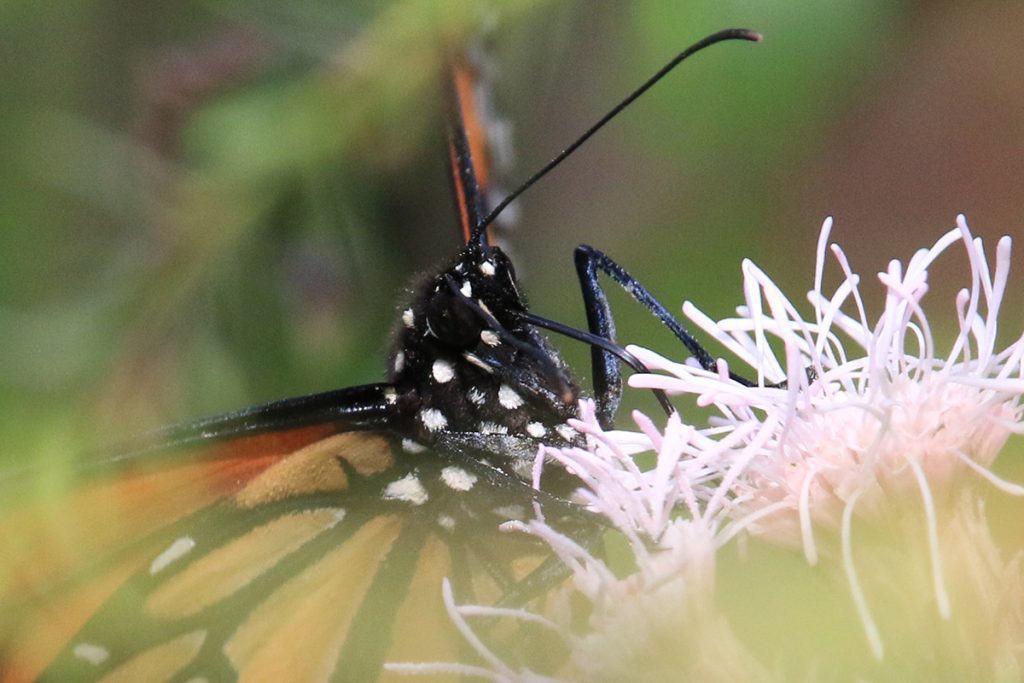
Dig Deeper into Backyard Ecology
What can we do to invite butterflies, birds, and other wildlife into our yards? And what about the flora and fauna that makes its way into our yards; the weeds, insects, and other critters that create the home ecosystem? WFSU Ecology Blog takes a closer look.

